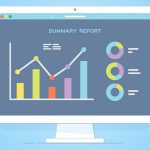5 Steps to Better Google Analytics Reporting
As with anything in life, it is important to have a plan. I recently spent more than six hours completing online Google Analytics training and then passed the Google Analytics IQ certification. While I learned a lot, one of my favorite things was learning about the value of Google’s measurement plan.
A measurement plan helps you identify the important metrics for your website, how to measure those metrics, and what strategies will make the results of those metrics grow.
If you do not have a measurement plan, you won’t know how any of the hundreds of metrics in Google Analytics apply to your website’s objectives.
Google recommends following a five-step measurement plan before adding Google Analytics to your website. I am going to walk you through those steps, explain in easy-to-understand terms what they mean, and provide examples of how these steps are important regardless of the type of website you run.
Step 1: Define Your Website’s Objective
Try to come up with one sentence that explains what you are trying to achieve with your website. Google believes every website can be at least broadly defined as one of five types:
- Selling a product or service.
- Generating leads for your sales team, email marketing, or similar purpose.
- Helping readers solve some kind of problem.
- Create awareness of a brand (this could be your personal brand or a company/product brand).
- Encourage people to visit your blog or share content.
It is even possible to have multiple objectives for one website, but they usually intersect. For example, you might encourage frequent visits to your blog because that increases the likelihood someone will purchase a product on your website.
Step 2: Identify Strategies for Your Website
Your strategy is how you plan to achieve your objective as defined in step No. 1. Here are a few examples of the kinds of strategies you might need for your website:
- For selling goods and services, you want to determine how to set up your e-commerce funnel (the path your customers make to purchase something) to maximize conversions.
- For generating leads, you want to make sure you have sign-up forms strategically placed and designed for visibility.
- If you are trying to help readers, your strategy will be more about the content itself and making sure it finds the right audience.
- Creating brand awareness can be anything on your website that highlights parts of your brand you are currently trying to make the target audience aware of.
- For getting people to frequent your blog, you might have email campaign and social media strategies to consider.
You can always have more than one strategy, just make sure they work with each other without interference and that you aren’t trying to do too much at once.
Step 3: Choose Your Strategies’ KPIs
Your KPI (Key Performance Indicators) are the metrics used to measure the effectiveness of your strategies. You should have at least two to three KPIs to measure for each strategy.
- For e-commerce, your goals are going to be metrics such as average order revenue, conversion rates, and shopping cart abandonment rates.
- For generating leads you should set up event tracking to measure what forms get filled out and where. Also, setting up goals and assigning values gives you a nice monetary metric to show your boss.
- Some good KPIs for getting visitors to read helpful content are page views and average time on page. If the average time on the page for your 800 word article is 20 seconds, you know something isn’t right.
- One way to measure brand awareness are visits per user (it can show if loyalty has increased from your branding efforts).
- Some good KPIs for blog engagement are return visitors, social shares, and blog comments.
With hundreds of metrics and dimension on Google Analytics, finding the right ones for your business objective and strategy can take some time and research.
Step 4: Decide How to Segment the Data
Not all visitors are the same. Looking at data in aggregate gives you an imprecise idea of what your data means. It is important to segment your visitors to understand how different groups impact your KPIs. This can be useful when revising your business strategy or when figuring out where to advertise for your website.
- Age: 18- to 24-year-olds are going to behave differently on your site than older age groups. Without segmenting your metrics by age you could make incorrect assumptions about your data.
- Gender: You might find out that females are more likely to complete an e-commerce transaction than men.
- Acquisition source: Maybe you learn that the high bounce rates for you website are mainly caused by one acquisition source. This helps you see that your content isn’t causing people to leave your website, the acquisition source is just causing bias.
- New vs Repeat Visits: This can be helpful for seeing if new visitors or repeat visitors are more likely to visit certain pages such as ones part of your e-commerce funnel.
- Geographic locations: You might find out that people in Florida share more things from your website than everywhere else combined.
These are far from the only kinds of segments you can utilize. The sky is the limit when you are deciding meaningful ways to segment your data.
Step 5: Choose Target Goals for the KPIs
Without a target you are just shooting in the dark. With a target, you will know how you are doing in relation to your goal. It also helps you understand if you need to revise your strategy to achieve your goals. Your target should have some kind of measurable number and a time period in which you want the goal achieved.
- We want to increase e-commerce revenue by 10% this quarter.
- We want to increase lead generation by 14% by the holiday season.
- We want to increase average time on page to a minute and a half in the next three articles.
- We want our brand awareness campaign to double pages per visitor in two months.
- We want the number of social shares on Twitter to surpass social shares of Facebook this year.
Now it is time to make your own plan. It doesn’t have to be perfect the first time and it is something you will end up revising on a fairly regular basis. The more familiar you get with Google Analytics, the better you measurement planning will be.




